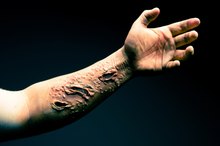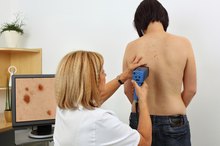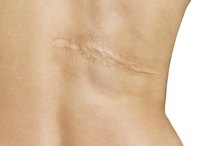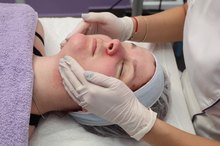What does fact checked mean?
At Healthfully, we strive to deliver objective content that is accurate and up-to-date. Our team periodically reviews articles in order to ensure content quality. The sources cited below consist of evidence from peer-reviewed journals, prominent medical organizations, academic associations, and government data.
- Bayat A, et al. (2003). Skin scarring.
- Bayat A, et al. (2003). Skin scarring.
- Gozali MV, et al. (2015). Effective treatments of atrophic acne scars.
- Gozali MV, et al. (2015). Effective treatments of atrophic acne scars.
- Keloid scar. (2018).
The information contained on this site is for informational purposes only, and should not be used as a substitute for the advice of a professional health care provider. Please check with the appropriate physician regarding health questions and concerns. Although we strive to deliver accurate and up-to-date information, no guarantee to that effect is made.
Loss of Pigmentation Due to Scarring
The color of the skin is due to the presence of a protein known as melanin. Melanin is made by cells known as melanocytes, which are present in the deeper layers of the skin. In some cases, an injury to the skin can cause patches of abnormally light skin, also known as hypopigmented regions, to appear. In many cases, these regions can surround a scar.
Mechanism
Hypopigmentation of areas of the skin often occurs after any sort of inflammation or injury to the skin, SkinSight.com explains. When the skin is damaged, the surrounding area often becomes inflamed as the body attempts to repair the damaged area. The inflammation can damage healthy cells, however, including melanocytes. Damaged melanocytes produce less melanin, which can result in hypopigmentation around any area which has become scarred.
- Hypopigmentation of areas of the skin often occurs after any sort of inflammation or injury to the skin, SkinSight.com explains.
- Damaged melanocytes produce less melanin, which can result in hypopigmentation around any area which has become scarred.
Diagnosis
White Blotches on the Chest
Learn More
Hypopigmentation due to skin inflammation, also known as post-inflammatory hypopigmentation, is notable for patches of unusually light skin. Often these hypopigmented areas have an irregular outline, PatientUK notes. Although it is possible for all of the melanin in the cells to be eliminated, in most cases, the loss of pigment is only partial. In areas in which the skin has become scarred, the hypopigmented region often encircles the scar.
- Hypopigmentation due to skin inflammation, also known as post-inflammatory hypopigmentation, is notable for patches of unusually light skin.
- In areas in which the skin has become scarred, the hypopigmented region often encircles the scar.
Risk Factors
People with dark skin are more likely to suffer from post-inflammatory hypopigmentation. This is primarily because the darker skin will provide more of a contrast with even mildly depigmented regions compared to lighter skin. Any sort of injury to the skin which is severe enough to cause scarring, such as scrapes, cuts or burns, can cause this lightening of the skin 1.
Treatment
Skin Disorders That Cause Pigment Loss
Learn More
As a general rule, areas of hypopigmented skin which are due to some skin injury or damage will return to their normal color after several months, MerckMedicus reports. This is because the melanocytes will either be repaired or replaced over time, which will allow for normal melanin production to resume. **If there is some underlying problem that is causing the inflammation and scarring, however, the skin will not regain its normal color unless the underlying disorder is treated 1.
Conisderations
Although the hypopigmented skin around a scar may eventually regain its original pigmentation, the actual scar tissue may persist in having a different color than the surrounding skin. This is because scar tissue is different than normal skin and has no melanocytes. Scars can be treated using a variety of approaches, including chemical peels, microdermabrasion and topical creams to help them heal better and to fade in appearance, but until the scar completely goes away, it will often have a different color than the surrounding skin.
Related Articles
References
- Bayat A, et al. (2003). Skin scarring.
- Gozali MV, et al. (2015). Effective treatments of atrophic acne scars.
- Keloid scar. (2018).
- Kanitakis J. Anatomy, histology and immunohistochemistry of normal human skin. Eur J Dermatol. 2002 Jul-Aug;12(4):390-9.
- Habif TP. Clinical Dermatology E-Book. 5th ed. Elsevier Health Sciences; 2009.
- Dutton J, Gayre G, Proia A. Diagnostic Atlas of Common Eyelid Diseases. New York: Taylor & Francis Ltd.; 2007:1. doi:10.3109/9781420016321
- Alberts B, Johnson A, Lewis J, Raff M, Roberts K, Walter P. Molecular Biology of the Cell, 4th ed. New York: Garland Science; 2002.
- Kakasheva-Mazhenkovska L, Milenkova L, Gjokik G, Janevska V. Variations of the histomorphological characteristics of human skin of different body regions in subjects of different age. Prilozi. 2011;32(2):119-28.
- Sandby-Møller J, Poulsen T, Wulf HC. Epidermal thickness at different body sites: relationship to age, gender, pigmentation, blood content, skin type and smoking habits. Acta Derm Venereol. 2003;83(6):410-3. doi:10.1080/00015550310015419
- Rahrovan S, Fanian F, Mehryan P, Humbert P, Firooz A. Male versus female skin: What dermatologists and cosmeticians should know. Int J Womens Dermatol. 2018 Jun 22;4(3):122-130. doi:10.1016/j.ijwd.2018.03.002
Writer Bio
Adam Cloe has been published in various scientific journals, including the "Journal of Biochemistry." He is currently a pathology resident at the University of Chicago. Cloe holds a Bachelor of Arts in biochemistry from Boston University, a M.D. from the University of Chicago and a Ph.D. in pathology from the University of Chicago.









